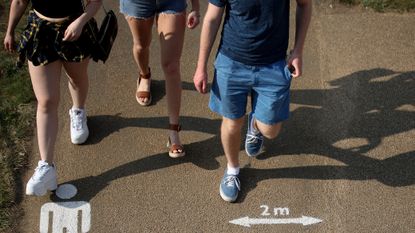Coronavirus: what is the R value and why does it matter?
Boris Johnson says Britain has reached coronavirus peak as R value falls

Boris Johnson has pledged to explain next week how schools and workplaces will safely reopen once lockdown restrictions are eased, as he claimed the UK was past the peak of the coronavirus outbreak.
Despite announcing an increase of 674 in the death toll of the virus, the prime minister suggested the worst was over.
The Guardian notes that Johnson “laid particular emphasis on the R value”, a figure the government has been attempting to keep below 1.
Subscribe to The Week
Escape your echo chamber. Get the facts behind the news, plus analysis from multiple perspectives.

Sign up for The Week's Free Newsletters
From our morning news briefing to a weekly Good News Newsletter, get the best of The Week delivered directly to your inbox.
From our morning news briefing to a weekly Good News Newsletter, get the best of The Week delivered directly to your inbox.
But what is the R value - and why does this figure hold the key to ending the lockdown?
What is an R value?
The R value - also known as R0 or R naught - refers to the average number of people that one infected person will go on to infect. As such, it is a measure of how transmissible, or contagious, a disease is - but not how deadly.
Scientists use the R value to “predict how far and how fast a disease will spread, and the number can also inform policy decisions about how to contain an outbreak”, says the Daily Express.
As Business Insider notes, an R value of one means the “average person who gets that disease will transmit it to one other person” - or in other words, the disease is spreading at a stable rate.
But “an R0 of more than one means the disease spreads exponentially”, the news site adds.
Diseases with exceptionally high R values include measles, with an average estimated value of 18, and mumps, with a value of ten, Healthline reports.
Although government advisers have suggested that the UK’s R value for the new coronavirus is stable or even dropping, modelling has shown that in most cases where lockdown measures are lifted, the R value quickly rises above one.
This was seen in Germany, which last week considered the reintroduction of strict lockdown measures after Chancellor Angela Merkel warned that hospitals in Germany could be overwhelmed by the end of June if the R value rises even slightly.
–––––––––––––––––––––––––––––––For a round-up of the most important stories from around the world - and a concise, refreshing and balanced take on the week’s news agenda - try The Week magazine. Start your trial subscription today–––––––––––––––––––––––––––––––
What is the current situation in the UK?
The Guardian reports that the government’s scientific advisers currently believe the R value to be “between 0.6 and 0.9”. However, England’s chief medical officer, Chris Whitty, has urged caution.
“As soon as R goes over one, then you restart exponential growth – it may be slow if it is just over one, it may be a lot faster if it goes a lot above one – but exponential growth restarts and, sooner or later – and the higher it is, the sooner it is – the NHS will go back to the risk of being overwhelmed and the number of cases will go up,” Whitty told yesterday’s daily briefing.
As Sky News notes, decreasing the rate of infections to a “manageable level” is one of the government’s five tests that must be satisfied before the lockdown is lifted.
“The number of confirmed cases of coronavirus has been steadily decreasing,” the broadcaster says, “although it is accepted that the true number of cases is likely to be much higher than the reported amount”.
Create an account with the same email registered to your subscription to unlock access.
Sign up for Today's Best Articles in your inbox
A free daily email with the biggest news stories of the day – and the best features from TheWeek.com
-
 'Republicans want to silence Israel's opponents'
'Republicans want to silence Israel's opponents'Instant Opinion Opinion, comment and editorials of the day
By Harold Maass, The Week US Published
-
 Poland, Germany nab alleged anti-Ukraine spies
Poland, Germany nab alleged anti-Ukraine spiesSpeed Read A man was arrested over a supposed Russian plot to kill Ukrainian President Zelenskyy
By Peter Weber, The Week US Published
-
 Today's political cartoons - April 19, 2024
Today's political cartoons - April 19, 2024Cartoons Friday's cartoons - priority delivery, USPS on fire, and more
By The Week US Published
-
 Dengue hits the Americas hard and early
Dengue hits the Americas hard and earlySpeed Read Puerto Rico has declared an epidemic as dengue cases surge
By Peter Weber, The Week US Published
-
 Covid four years on: have we got over the pandemic?
Covid four years on: have we got over the pandemic?Today's Big Question Brits suffering from both lockdown nostalgia and collective trauma that refuses to go away
By Chas Newkey-Burden, The Week UK Published
-
 How happy is Finland really?
How happy is Finland really?Today's Big Question Nordic nation tops global happiness survey for seventh year in a row with 'focus on contentment over joy'
By Harriet Marsden, The Week UK Published
-
 The hollow classroom
The hollow classroomOpinion Remote school let kids down. It will take much more than extra tutoring for kids to recover.
By Mark Gimein Published
-
 How Tehran became the world's nose job capital
How Tehran became the world's nose job capitalUnder the radar Iranian doctors raise alarm over low costs, weak regulation and online influence of 'Western beauty standards'
By Harriet Marsden, The Week UK Published
-
 Africa's renewed battle against female genital mutilation
Africa's renewed battle against female genital mutilationUnder the radar Campaigners call for ban in Sierra Leone after deaths of three girls as coast-to-coast convoy prepares to depart
By Harriet Marsden, The Week UK Published
-
 Excess screen time is making children only see what is in front of them
Excess screen time is making children only see what is in front of themUnder the radar The future is looking blurry. And very nearsighted.
By Devika Rao, The Week US Published
-
 Argentina: the therapy capital of the world
Argentina: the therapy capital of the worldUnder the radar Buenos Aires natives go hungry to pay for psychoanalysis, amid growing instability, anxiety – and societal acceptance
By Harriet Marsden, The Week UK Published